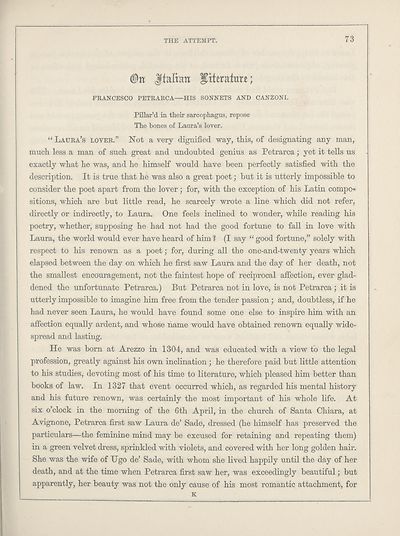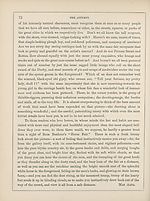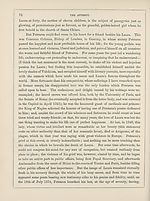Download files
Complete book:
Individual page:
Thumbnail gallery: Grid view | List view

THE ATTEMPT. 73
#it Jlalhrn '§xitXRtmt;
FRANCESCO PETRAECA HIS SONNETS AND CANZONI.
Pillar'd in their sarcophagus, repose
The bones of Laura's lover.
" Laura's lover." Not a very dignified way, this, of designating any man,
much less a man of such great and undoubted genius as Petrarca; yet it tells us
exactly what he was, and he himself would have been perfectly satisfied with the
description. It is true that he was also a great poet; but it is utterly impossible to
consider the poet apart from the lover; for, with the exception of his Latin compo¬
sitions, which are but little read, he scarcely wrote a line which did not refer,
directly or indirectly, to Laura. One feels inclined to wonder, while reading his
poetry, whether, supposing he had not had the good fortune to fall in love with
Laura, the world would ever have heard of him'/ (I say " good fortune," solely with
respect to his renoAvn as a poet; for, during all the one-and-twenty years which
elapsed between the day on which he first saw Laura and the day of her death, not
the smallest encouragement, not the faintest hope of reciprocal affection, ever glad¬
dened the unfortunate Petrarca.) But Petrarca not in love, is not Petrarca; it is
utterly impossible to imagine him free from the tender passion; and, doubtless, if he
had never seen Laura, he would have found some one else to ins2:)ire him with an
affection equally ardent, and whose name would have obtained renown equally wide¬
spread and lasting.
He was born at Arezzo in 1304, and was educated with a view to the legal
profession, greatly against his own inclination; he therefore paid but little attention
to his studies, devoting most of his time to literature, which pleased him better than
books of law. In 1327 that event occurred which, as regarded his mental history
and his future renown, was certainly the most important of his whole life. At
six o'clock in the morning of the 6th April, in the church of Santa Chiara, at
Avignone, Petrarca first saw Laura de' Sade, dressed (he himself has preserved the
particulars—the feminine mind may be excused for retaining and repeating them)
in a green velvet dress, sprinkled with violets, and covered with her long golden hair.
She was the wife of Ugo de' Sade, with whom she lived happily untU the day of her
death, and at the time when Petrarca first saw her, was exceedingly beautiful; but
apparently, her beauty was not the only cause of his most romantic attachment, for
K
#it Jlalhrn '§xitXRtmt;
FRANCESCO PETRAECA HIS SONNETS AND CANZONI.
Pillar'd in their sarcophagus, repose
The bones of Laura's lover.
" Laura's lover." Not a very dignified way, this, of designating any man,
much less a man of such great and undoubted genius as Petrarca; yet it tells us
exactly what he was, and he himself would have been perfectly satisfied with the
description. It is true that he was also a great poet; but it is utterly impossible to
consider the poet apart from the lover; for, with the exception of his Latin compo¬
sitions, which are but little read, he scarcely wrote a line which did not refer,
directly or indirectly, to Laura. One feels inclined to wonder, while reading his
poetry, whether, supposing he had not had the good fortune to fall in love with
Laura, the world would ever have heard of him'/ (I say " good fortune," solely with
respect to his renoAvn as a poet; for, during all the one-and-twenty years which
elapsed between the day on which he first saw Laura and the day of her death, not
the smallest encouragement, not the faintest hope of reciprocal affection, ever glad¬
dened the unfortunate Petrarca.) But Petrarca not in love, is not Petrarca; it is
utterly impossible to imagine him free from the tender passion; and, doubtless, if he
had never seen Laura, he would have found some one else to ins2:)ire him with an
affection equally ardent, and whose name would have obtained renown equally wide¬
spread and lasting.
He was born at Arezzo in 1304, and was educated with a view to the legal
profession, greatly against his own inclination; he therefore paid but little attention
to his studies, devoting most of his time to literature, which pleased him better than
books of law. In 1327 that event occurred which, as regarded his mental history
and his future renown, was certainly the most important of his whole life. At
six o'clock in the morning of the 6th April, in the church of Santa Chiara, at
Avignone, Petrarca first saw Laura de' Sade, dressed (he himself has preserved the
particulars—the feminine mind may be excused for retaining and repeating them)
in a green velvet dress, sprinkled with violets, and covered with her long golden hair.
She was the wife of Ugo de' Sade, with whom she lived happily untU the day of her
death, and at the time when Petrarca first saw her, was exceedingly beautiful; but
apparently, her beauty was not the only cause of his most romantic attachment, for
K
Set display mode to: Large image | Transcription
Images and transcriptions on this page, including medium image downloads, may be used under the Creative Commons Attribution 4.0 International Licence unless otherwise stated. ![]()
| Ladies' Edinburgh Debating Society publications > Attempt > Volume 3 > (87) Page 73 |
|---|
| Permanent URL | https://digital.nls.uk/104344276 |
|---|
| Attribution and copyright: |
|
|---|

